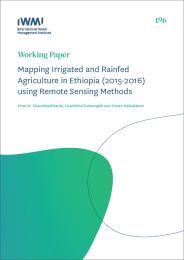IWMI Working Paper – 196
Citation:
Chandrasekharan, K. M.; Subasinghe, C.; Haileslassie, A. 2021. Mapping irrigated and rainfed agriculture in Ethiopia (2015-2016) using remote sensing methods. Colombo, Sri Lanka: International Water Management Institute (IWMI). 31p. (IWMI Working Paper 196). doi: https://doi.org/10.5337/2021.206]
Irrigation expansion is a critical development intervention to address food security challenges in Ethiopia. However, only a fraction of the country’s irrigation potential has been utilized so far. Information about the location and spatial extent of irrigated and rainfed areas is an important requirement for sustainable water resources development and agricultural planning. Currently, considerable variations exist in the irrigated area estimates made by different government agencies. In addition, irrigated area maps created as part of global mapping efforts have a spatial resolution of anywhere between 10 kilometers and 250 meters, making them too coarse for planning and management at a subnational scale. This study aims to develop an irrigated area map of Ethiopia using satellite images to support agricultural water management practices in the country, using multi-temporal, multi-resolution data sets from 2015 to 2016 with a spatial resolution of 30 m. The total area of croplands was estimated as 21.8 million hectares (Mha), of which only 1.11 Mha were mapped as the irrigated area. This is only around 5% of the estimated total agricultural area. The accuracy of the results was evaluated using geographic coordinates of irrigated areas provided by the Ethiopian Ministry of Agriculture. The results confirmed that irrigated areas can be identified reasonably well by analyzing seasonal trends in vegetation and moisture levels.
ISSN 2012-5763
e-ISSN 2478-1134
ISBN 978-92-9090-913-2


